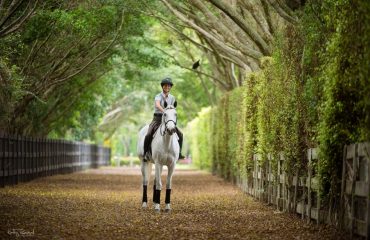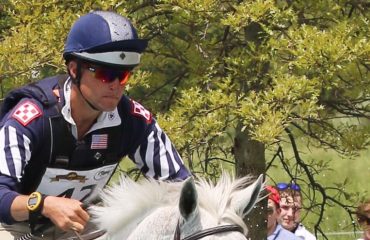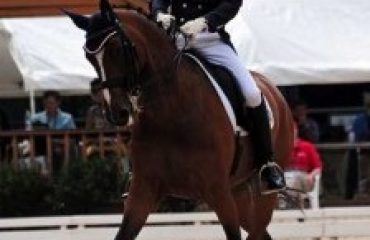By Shya Beth

Ancient artifacts, weathered down to their pure essence, embody powerful inspiration for Amy Laugesen’s ceramic and mixed media equine sculptures.
Her sculpted creations hearken back to objects of antiquity that are familiar in museums, often with arms, legs and head that have been broken off and lost to time. Even with the obvious brokenness, the form, gesture and spirit of the ancient statues and sculptures are still recognizable.
Amy finds working with clay a process similar to working with horses. “Sometimes I start with a concept and other times I start with a large block of clay and begin to work it to reveal the horse or horses that show themselves at the moment,” she said. “What I continue to learn is that creativity is an organic process that ebbs and flows, and to not hold on too tight: to relax, breathe, stay within the moment and enjoy the ‘ride’ with calm confidence and perseverance. Equestrians can understand this—if I hold on too tight, use force or rush the process, it won’t work out. Like working with a horse, I meet resistance from the clay and my sculpture may not be successful—possibly even blowing up in the kiln!”
It’s a daily practice of trusting the creative process and embracing the unknown for Amy. To take the subject of the horse, to discover the essence of a horse within the mud and then transform this into contemporary ceramic artworks remains her artistic passion. Each sculpture carries its own unique personality and story. The base is the final and an integral part of the sculpture. Ceramic, metal or a found object are used to complete the sculpture and add to the story of the sculpture, but there’s a lot more to the process between sculpting and finalizing the base.
“Once I have the horse form sculpted, the piece has to survive two firings in a kiln: the bisque firing and then the final glaze firing. I choose ceramic glazes and surface treatments to give the sculptures a sense of history,” Amy said. “My internship in the conservation lab at the Boston Museum of Fine Arts and apprenticeship as an Outdoor Sculpture Maintenance Technician during my college years still helps inform my understanding of patinas on a variety of objects of antiquity.”
 Art as a Language
Art as a Language
“Realizing art was my language, I knew I wanted to pursue a career in arts when I was in high school,” Amy said. “My first experiences with horses, and with art, were both at a young age. There were stables near my childhood home in Denver, Colorado, and my family would take trail rides in the Rocky Mountains and attend Denver’s annual National Western Stock Show every year in January. I have a memory of drawing a three-legged horse while at preschool, and my teacher asked, ‘Why only three legs? Horses have four legs.’ I remember being frustrated by having to explain to my teacher that the horse is running so you only see three of its legs; one leg is behind the other. That’s where it all began.”
As she took riding lessons and did chores at the barn to save up to purchase a horse of her own, Amy’s early adolescence also came with some challenges. Struggling in school with dyslexia and low self-esteem led to an eating disorder, which led her to ultimately lean on her art classes at school and being with horses to help navigate the emotional turbulence of being a teenager. A chestnut Quarter Horse with white markings named Tic Tac saved her life and is forever her muse for her art.
Amy competed in horse shows across Colorado and participated in Pony Club with Tic Tac and other horses that fueled her dream of riding for the U.S. Equestrian Team in the Olympics, but ultimately her path led to art. Going to college meant leaving Tic Tac behind when she attended Marymount Palos Verdes College, now Marymount California University, to improve her portfolio and to study graphic design and illustration. That’s when horses became the central subject of her early artworks.
 “With the guidance of several professors, I discovered that mixed media sculpture was my form of self-expression, which horses continued to show up in. After receiving my associate of arts degree from Marymount in 1988, I ventured east to Boston, Massachusetts, and opened a new chapter of life, to assist my aunt with her research about my maternal great-grandfather, connect with my artistic East Coast heritage and complete my BFA studies at the School of the Museum of Fine Arts Boston and Tufts University,” she said.
“With the guidance of several professors, I discovered that mixed media sculpture was my form of self-expression, which horses continued to show up in. After receiving my associate of arts degree from Marymount in 1988, I ventured east to Boston, Massachusetts, and opened a new chapter of life, to assist my aunt with her research about my maternal great-grandfather, connect with my artistic East Coast heritage and complete my BFA studies at the School of the Museum of Fine Arts Boston and Tufts University,” she said.
Amy’s maternal great-grandfather was New England sculptor Bela Lyon Pratt (1867-1917), a prominent figure in the American art world at the turn of the century. He studied at the Art Students League-New York and Yale School of Fine Art, and received his graduate degree from Harvard. He apprenticed under the accomplished Augustus St. Gaudens, and is credited with 180 significant sculptures including a monument to Captain Nathan Hale located at Yale University, and was the head of the Sculpture Department at the School of the Museum of Fine Arts in Boston.

With her artistic lineage, along with experiences and education on both the east and west coasts, Amy has been shaped as a mixed media sculptor by many influences—influences that have also shaped the direction of her life. “I feel horses will always continue to show up in my work, and recently had fun creating a horse from rusted baling, fencing and barbed wires and other rusted artifacts from around my home in the San Luis Valley of Colorado. I do have aspirations to explore other subjects and mediums—for years I’ve had a project in mind that is inspired by small drawings by my maternal grandmother, Elisabeth Pratt Kennedy, who was also an artist. She died when I was an infant, so I have no personal memories of her. I’m looking forward to the journey my art will take me on in the future!”
For more information visit amylaugesen.com
All photos courtesy of A. Laugesen Studio. Photos by Stephen Hume, unless noted otherwise
















